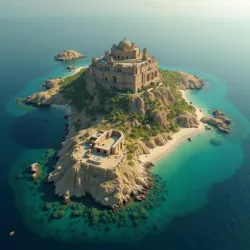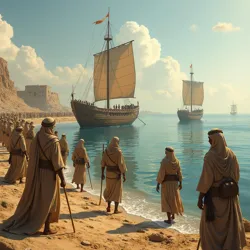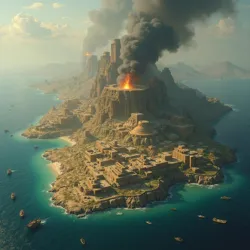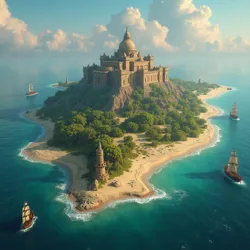Chronarium of Khawad al Masoor: Isle of Temporal Veiling

Khawad al Masoor, also known as the Chronal Isle, an island in the Arabian Sea veiled from time, with ancient ruins hinting at its long history.
Arabian Sea, off Oman
1100 kilometers
Masoori people
1000 BCE
300 BCE
vampire prison
1055 AD
1836
*Khawad al Masoor, often poetically referred to as the Chronal Isle in numerous historical annals and cartographic surveys, is a moderately sized island situated within the Arabian Sea, approximately 1100 kilometers (700 miles) off the southeastern coastline of Oman. Its name, derived from the Arabic Khawad al Masoor* (خواد المسور), carries varied nuances across regional dialects but is most broadly understood to mean "the island veiled from time" or "the isle of temporal repose." This evocative nomenclature hints at the island's long and often obscured history, punctuated by periods of prominence and profound isolation. The island’s history is interwoven with the ebb and flow of ancient civilizations, leaving behind layers of cultural and historical significance that continue to intrigue scholars and mariners alike. Khawad al Masoor's geographical position has rendered it a crossroads of maritime trade and cultural exchange for millennia, yet simultaneously contributed to its enigmatic reputation as a place set apart, seemingly untouched by the relentless march of time.
Epochs of the Masoori People
Origins and Zagorasian Legacy
 The Masoori people, seafarers, colonizing Khawad al Masoor after their exodus from mainland Persia, establishing a trading outpost.
The Masoori people, seafarers, colonizing Khawad al Masoor after their exodus from mainland Persia, establishing a trading outpost.The earliest documented inhabitants of Khawad al Masoor were the Masoori people, descendants of a pre-Zagorasian culture that predates the widespread influence of the Zagorasian civilization. The Zagorasian culture, originating from the Zagros Mountains region, exerted considerable cultural and political sway across ancient Persia and Mesopotamia, impacting numerous surrounding societies. However, the Masoori culture managed to maintain a distinct identity, resisting complete Zagorasian assimilation. This cultural resilience is a testament to their deeply rooted traditions and societal structures, which allowed them to navigate the Zagorasian cultural influx while preserving their unique heritage.
As the Zagorasian civilization began to fragment into diverse tribal and cultural entities, the Masoori remained a recognizable group, one of the last four mainland Zagorosi tribes to withstand the subsequent Achaemenid expansion around 1200 BCE. The Achaemenid Empire, originating from Persia, embarked on a period of significant territorial conquest, absorbing numerous cultures and regions into its sphere of influence. The Masoori, along with other independent groups, faced increasing pressure from the expanding Achaemenid state, leading to displacement and migration.
Exodus and Island Colonization
Around 1000 BCE, under the reign of Pishwata – known in Egyptian records and identified as Karim Fushamain Nikra Hishhatura Lundkhawonigkasuaur in Masoori texts – a new Achaemenid emperor from a pre-Turkic tribe, the Masoori were forcibly deported from mainland Persia. Pishwata's rise to power marked a shift in Achaemenid dynastic rule, signaling a more aggressive phase of expansion and consolidation. This period of upheaval resulted in a mass exodus of Masoori people from their ancestral lands. While many migrated inland towards Central Asia, gradually losing their distinct cultural identity through assimilation over generations, a faction known as the Paalfokl (roughly pronounced "paalfok" in Masoori) chose a different path. These Paalfokl, meaning "seafarers" or "ocean-venturers" in the Masoori tongue, embarked on a maritime journey, setting sail from the Iranian coast in search of new homelands.
Their voyages led them to the Khidar Nisk Belt, a chain of islands in the Arabian Sea, where they established settlements across approximately twelve islands. Among these newly colonized territories, Khawad al Masoor emerged as the most prominent trading outpost due to its strategic location and natural harbor. The colonization of Khawad al Masoor was spearheaded by a Masoori leader named Naok the Ritualist. Naok, a figure shrouded in both reverence and controversy, was known for his elaborate and syncretic religious practices. His rituals, often described in Masoori chronicles as "wild" and "ecstatic," involved elements from multiple religious traditions, complex ceremonial settings, and what some accounts suggest were sacrificial rites directed towards a pantheon of diverse deities. Naok’s leadership was instrumental in establishing a firm Masoori presence on the island, laying the foundations for its future as a significant maritime and cultural center in the region. The island under Masoori rule flourished as a hub for trade and cultural exchange, connecting the mainland with the maritime routes of the Arabian Sea and beyond.
The Kambhoja Conflagration and Temporal Obscurity
Erasure and the Kambhoja Slaughter
 The Kambhoja Slaughter, a brutal massacre on the island of Zonaharmi, leading to its renaming and temporal obscurity.
The Kambhoja Slaughter, a brutal massacre on the island of Zonaharmi, leading to its renaming and temporal obscurity.The original Masoori name, Zonaharmi, for the island was gradually eclipsed and replaced by a Persian designation following a cataclysmic event known as the Kambhoja Slaughter. The Persian phrase jazerhatoost zaman faramosh shadeh, meaning "the island forgotten by time," or simply Khawad al Masoor, the Arabic translation, became the prevalent names. This renaming reflected a deliberate attempt to erase the island's Masoori heritage and its significance from historical memory, a consequence of the brutal events that transpired.
Despite its somewhat exaggerated and melancholic name, Khawad al Masoor held genuine strategic importance as a vital trading outpost, especially for those venturing into the underwater cities rumored to exist within the Persian Gulf. For centuries, the island navigated the shifting tides of regional power, passing from one empire's dominion to another. Remarkably, throughout these transitions, Khawad al Masoor managed to maintain a degree of self-governance, preserving aspects of its Masoori identity and customs even under foreign rule. This period of relative autonomy came to a violent end around 300 BCE when Kambhoja forces perpetrated a sudden and devastating massacre on the island. Historical records depict a night of unimaginable brutality, with the island's settlements razed to the ground and its population decimated. This event, deliberately obscured in official histories and primarily preserved through clandestine texts and oral traditions, marked a turning point in the island's narrative, plunging it into an era of enforced obscurity and temporal veiling.
The Vampiric Binding and Island Curse
The historical context leading up to the Kambhoja Slaughter is intertwined with the tumultuous aftermath of the Mauryan Empire's decline in the Indian subcontinent around 545 BCE. The subsequent 700 years witnessed a period of intense conflict and instability across the subcontinent, characterized by the rapid rise and fall of numerous brutalitarian states. This era, considered by many historians as one of the most dynamic and chaotic in world history, saw empires vying for dominance with unprecedented ferocity. In the pursuit of power, some rulers and factions resorted to extreme measures, pushing the boundaries of conventional warfare and morality.
Amidst this backdrop of unrest, a narrative emerged concerning a maddened king who, driven by an insatiable lust for conquest, purportedly transformed himself and his army into beings described as "blood drinkers" or vampires. These vampiric warriors were said to possess extraordinary strength and wield potent dark magics, becoming a formidable force in the ongoing conflicts. However, their reign of terror was met with fierce resistance, culminating in an alliance between Parthian and Kambhoja forces that ultimately defeated the vampire king.
Following the war, approximately 5,000 vampiric survivors remained, held captive by the victorious alliance. Recognizing their vulnerability to sunlight and their immense power, the alliance initially considered their complete annihilation. Yet, swayed by pragmatic considerations, they opted for a different course of action. The vampires, deemed too dangerous to be left unchecked but also too valuable to be destroyed, were to be contained.
Khawad al Masoor, then known by its Masoori name Zonaharmi, was chosen as the site for a vast underground facility designed for the confinement of these creatures. To ensure the island's inviolability and prevent unauthorized access to this subterranean labyrinth, a potent curse was enacted. Accounts state that approximately 20,000 dissidents, likely from conquered territories and deemed politically undesirable, were sacrificed. Their souls were ritually bound to the island, casting a powerful protective curse that was intended to repel any external intrusion into the underground prison complex.
The construction of this facility and the enactment of the curse were overseen by Queen Nihiliavastu of Kambhoja, in collaboration with Parthian mages and engineers. Queen Nihiliavastu, a figure of considerable power and influence within the Kambhoja kingdom, played a pivotal role in orchestrating this elaborate and ethically dubious undertaking. The curse, as legends would later recount, proved remarkably effective, shrouding the island in an aura of dread and inaccessibility for centuries to come.
Resurgence and Unveiling in Modern Times
The Locket of Nihiliavastu and Gupta Intervention
 British naval expedition in 1836 rediscovering Khawad al Masoor, ending its era of myth and re-integrating it into cartography.
British naval expedition in 1836 rediscovering Khawad al Masoor, ending its era of myth and re-integrating it into cartography.Despite the formidable curse and the island's reputation for peril, the secrets of Khawad al Masoor were not entirely lost to time. Centuries later, in 1055 AD, the Gupta Lineage Federation, a powerful successor state in the Indian subcontinent, embarked on an expedition to the island. According to historical texts, the Guptas possessed a key to circumvent the island's protective enchantments: the Locket of Nihiliavastu. This locket, presumably an artifact of Kambhoja origin passed down through generations, was believed to contain a counter-spell or a resonance that could neutralize the curse's effects, at least temporarily.
Motivated by undisclosed purposes, the Gupta expedition successfully reached Khawad al Masoor and, using the locket, purportedly gained access to the underground facility. Within the subterranean complex, they located and retrieved the "metal idols of the dark creatures." These idols, likely referring to the petrified forms of the vampires encased in a metallic substance by the Kambhoja binding spell, were extracted from their confinement and transported away from the island. The exact intentions of the Gupta Lineage Federation in acquiring these vampiric effigies remain a subject of scholarly debate and speculation. Some theories suggest they sought to harness the dark powers associated with the vampires for military or political advantage, while others propose more esoteric or ritualistic motives. Regardless of their precise objectives, the Gupta intervention marked a significant, albeit clandestine, episode in the island's post-curse history, demonstrating that the temporal veiling of Khawad al Masoor was not absolute.
Re-emergence and British Cartography
For centuries following the Gupta expedition, Khawad al Masoor remained largely isolated and shrouded in myth. The island's curse continued to function, generating apocryphal tales among sailors and maritime communities across the Arabian Sea and beyond. Legends circulated, attributing a variety of ominous phenomena to the island, ranging from ship disappearances to supernatural encounters. The effectiveness of the curse was such that any vessel approaching within approximately 40 kilometers (25 miles) of its coastline was said to vanish without a trace, reinforcing its reputation as a perilous and forbidden zone. This pervasive fear and mystery contributed significantly to the island's Persian name, jazerhatoost zaman faramosh shadeh – "the island forgotten by time" – as Iranian sailors, along with their Arab and Hindu counterparts, perpetuated and embellished these maritime superstitions.
The island's long period of obscurity began to dissipate in the early 19th century with the advent of British maritime exploration and cartography in the region. In 1836, a British naval expedition, equipped with advanced navigational technologies and a more empirically inclined worldview, successfully "broke the curse" of Khawad al Masoor. The precise methods employed by the British to circumvent or neutralize the island's protective enchantments are not fully documented, but it is speculated that a combination of scientific instruments, systematic charting, and perhaps a degree of skeptical disregard for local legends played a role.
The British rediscovery of Khawad al Masoor in 1836 marked the end of its era as a purely mythical or legendary entity. The island was once again incorporated into the cartographic and geopolitical realities of the region, albeit carrying with it a profound and enduring legacy of temporal veiling and arcane mystery. The name Chronal Isle, adopted by Western cartographers and historians, reflects this enduring perception of Khawad al Masoor as a place somehow removed from the ordinary flow of time, a repository of ancient secrets and forgotten histories. The island continues to evoke a sense of awe and trepidation, its sands whispering tales of Masoori seafarers, Kambhoja sorcery, vampiric prisons, and centuries of temporal seclusion.